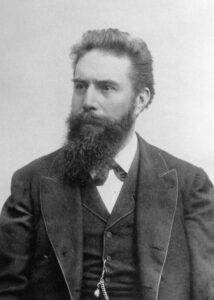Arpan K. Banerjee
Solihull, England
 |
| Wilhelm Conrad Röntgen. LIFE Photo Archive. Via Wikimedia. |
The name Röntgen will be familiar to most for his discovery of X-rays on November 8, 1895. This date is now celebrated as the International Day of Radiology.
Wilhelm Conrad Röntgen was born in Lennep, Germany on March 27, 1845. The house where he was born is now looked after by the German Radiology Society and can be visited by the public. Not far from this house is the Röntgen Museum, which opened in 1932. It is the only museum in the world dedicated to the life and work of this great scientist.
Röntgen’s early schooling was in Appeldoorn, Holland. In 1862, he entered the technical school in Utrecht, but did not do well there and failed to gain entrance to the university. In 1865, he entered the polytechnic in Zurich where he studied engineering. Here he met professor of physics August Kundt, who became his mentor. In 1869, he obtained his PhD for his study on gases. He followed Professor Kundt to Wurzburg in 1870 and became his assistant. He then moved to Strasbourg with Professor Kundt in 1874 and became the chair in physics at Hohenheim in Germany. He also held the chair at Giessen before settling in Wurzburg as Professor of Physics in 1888.
It was here that the fifty-year-old Röntgen made his momentous discovery. He had long been interested in vacuum tubes, and on November 8, 1895, he passed cathode rays through a Lenard tube with a thin aluminum window. A cardboard covering prevented light from passing through. Röntgen noted that a distally-placed screen painted with barium platinocyanide started to fluoresce. As light could not have caused this, it must have been due to another type of ray, which he called X-rays. Initially he did not believe his own results and repeated his experiments. A meticulous experimenter all his life, that evening he sensed the importance of his discovery. His preliminary findings were conveyed in the now classic paper “On a new kind of X-rays.” Röntgen gave a public lecture on the topic in Wurzburg, and his work appeared in the local newspapers before the findings began to generate publicity worldwide. Medicine was soon to be changed forever. The technique had introduced a new way of seeing inside the body and would be helpful to doctors in making diagnoses.
Röntgen published three papers on X-rays. He became the first recipient of the Nobel Prize in Physics in 1901, the year he took up the chair in physics in Munich. He was showered with honors, including the Rumford Medal of the Royal Society of London in 1896, as well as honorary memberships of many learned societies and institutions.
In addition to his work on X-rays, Röntgen made many contributions in the field of metallurgy, structural analysis, and crystallography, publishing more than fifty papers on topics other than X-rays.
Röntgen married Anna Bertha Ludwig in 1872. She was six years older. They had no children of their own but adopted Anna’s niece. Rontgen enjoyed holidays in the mountains, especially the Alps. He was essentially a shy man who was not fond of the company of his fellow physicists.
He retired from Munich in 1920 and died on Feb 10, 1923.
Röntgen could not have imagined how his discovery changed the way medicine would be practiced in the twentieth century and beyond. His laboratory has been preserved in Wurzburg in the Röntgen Memorial Museum and can be visited by interested members of the public. Today his name has been given to many prizes and medals in the field of radiology and physics by learned societies worldwide.
References
- Busch, Uwe, ed. Wilhelm Conrad Röntgen: A Shining Light for Science. Springer, 2021.
- Rosenbusch, Gerd and Annemarie de Knecht-van Ekelen. Wilhelm Conrad Röntgen: The Birth of Radiology. Springer, 2019.
- Thomas, Adrian MK and Arpan K Banerjee. The History of Radiology. Oxford University Press: 2013.
DR. ARPAN K. BANERJEE qualified in medicine at St Thomas’s Hospital Medical School, London. He was a consultant radiologist in Birmingham 1995–2019. He was President of the radiology section of the RSM 2005–2007 and on the scientific committee of the Royal College of Radiologists 2012–2016. He was Chairman of the British Society for the History of Radiology 2012–2017. He is Chairman of ISHRAD. He is author/co-author of papers on a variety of clinical, radiological, and medical historical topics and seven books, including Classic Papers in Modern Diagnostic Radiology (2005) and The History of Radiology (OUP 2013).

Leave a Reply